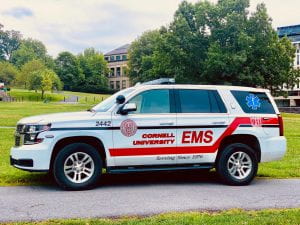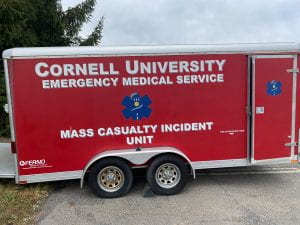CUEMS provides EMS service twenty-four hours a day, seven days a week during the academic year. CUEMS is also available throughout orientation, rush week, study period, exam weeks, graduation, and reunion. CUEMS has limited staffing during University breaks, and is usually unable to respond during these times of the year. The Emergency Services Group of Cornell University Environment, Health and Safety provides similar services to the Ithaca Campus when CUEMS is unavailable.
CUEMS members are trained through a rigorous clinical advancement process of four ranks.
Trainee: Every new member starts as a Trainee, regardless of prior experience or certification. Trainees are responsible for obtaining New York State certification, practicing skills, learning regional and agency protocols, and familiarizing themselves with local geography. After demonstrating proficiency in these areas, Trainees are responsible for completing a written and practical skills examination, allowing them to promote to the rank of attendant.
Attendant: The attendant is a competent non-primary emergency medical technician. Attendants are responsible for patient care under the supervision of an experienced provider. Attendants are expected to begin training in emergency vehicle operations and scene management, allowing them to advance to the rank of Crew Chief In-Training.
Crew Chief In-Training: The Crew Chief In-Training participates in weekly training exercises to supplement normal call volume, ensuring that providers are exposed to a wide variety of situations.
Crew Chief: The Crew Chief is a certified emergency vehicle operator with proficient knowledge of campus geography and superior knowledge of state and regional emergency medical protocols. The Crew Chief is the leader of the CUEMS crew and coordinates patient care and additional resources.
We are dispatched by the Cornell Public Safety Communication Center via a 800 MHz radio system. You may see our providers carrying two portable radios to allow crew members to coordinate with Tompkins County agencies responding to a scene as well as other Cornell units. Crews also have access to call information through an integrated dispatch software.
Office
Our office is located in the Environment, Health & Safety Building, located at 201 Palm Road, on the eastern end of the Ithaca Campus near the College of Veterinary Medicine. Our location allows for close relationships with other Cornell emergency responders, while still providing quick access to North, Central, and West Campuses. The Environment, Health & Safety Building includes space for our office, bunk room, and lounge spaces, allowing our members to work, sleep, and relax while they are on duty.
Fly Cars
Each of our response vehicles have aluminum cabinetry, movable trays and drawers, and other interior vehicle customization provide a comfortable, safe, and adjustable environment for the crew and maximize space for equipment to handle any type of situation. Our primary response vehicle carries a complement of basic life support equipment including airway management equipment, trauma management equipment, splinting equipment (including various fixation and traction methods), spinal immobilization equipment, basic life support medications (including epinephrine, albuterol, oxygen, glucose, and aspirin), BLS patient evaluation equipment (also including pulse oximetry and blood glucometry equipment), personal floatation devices (life jackets), helmets, eye and ear protection, cones and flares, ANSI-compliant vests and jackets, mass casualty command and triage equipment, pediatrics and obstetrics equipment, a stair chair, portable hand lights, blankets and pillows, additional oxygen and personal protective equipment, and training supplies for drills and mock calls.
Currently, we have three fly cars, two of which are used to respond to calls. We alternate using Cornell EMS 2441 (2015 Chevrolet Tahoe) and Cornell EMS 2442 (2019 Chevrolet Tahoe) each day during times of normal call volume, however we will put both vehicles in service if need is anticipated. Both vehicles are equipped with a laptop to allow crews to access dispatch information and fill out patient charts. Cornell EMS 2443 (2011 Chevrolet Tahoe) is used for transporting crews and equipment to event standbys and towing our Mass Casualty Incident Trailer. It also can serve as a reserve emergency response vehicle as needed.
Mass Casualty Incident Trailer
In 2007, CUEMS introduced our Mass Casualty Incident (MCI) Unit trailer to the fleet with assistance from the University’s Office of Risk Management and Insurance. The unit is designed to house equipment that allows our crews to triage, stabilize, and treat approximately one hundred patients in the event of a large scale emergency on campus or in the surrounding area. The trailer is the largest of its kind in Tompkins County and much of the surrounding region, making CUEMS a valuable resource to both Cornell University and the greater community.
As a component of the Cornell University emergency response system, we frequently work with the Cornell University Police Department (CUPD) and Cornell University Environment, Health and Safety. Members of CUEMS also work closely with a number of surrounding emergency service agencies in Tompkins County. As a first response agency, CUEMS does not transport patients; we transfer patient care to the Advanced Life Support (ALS) staff of Bangs Ambulance for transportation to the hospital. As part of the tiered emergency response system employed by Tompkins County, we often interact with the Ithaca and Cayuga Heights Fire Departments for serious medical emergencies, motor vehicle accidents, and incidents requiring technical assistance.


